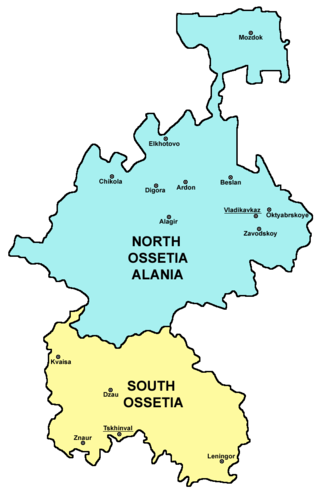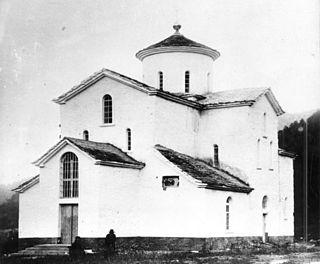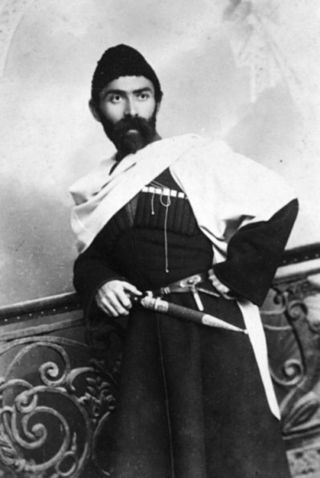
Ossetian nationalism is ethnic nationalist ideology promoting Ossetian national identity, the Ossetian language and culture.

Ossetian nationalism is ethnic nationalist ideology promoting Ossetian national identity, the Ossetian language and culture.
Ossetian national mythology traces the Ossetians’ ancestry to the first Iranian people to reach the Caucasus region, the ancient Scythians, who arrived to the North Caucasus by the 8th century B.C.E. Others claim that Ossetians are descended from the Sarmatians, who arrived to the region five centuries later. [1] Various Ossetian scholars regard Alans as the ancestors of the modern Ossetians. [2]
The Ossetian national ideology is rooted in the works of 19th century Ossetian scholar and poet Kosta Khetagurov, generally considered to be a founder of Ossetian literature. Khetagurov with his followers restandartized Ossetian script with a goal of uniting all groups speaking Ossetian language. Their national ideology was called farn and they argued for distinctiveness of Ossetian people and considered Orthodox Christian faith to be its important feature. [3]
The incipient collapse of the Soviet Union in the 1980s triggered projects of identity-building among many of its constituent nations. In Ossetia, as in other nations, this involved the recovery of an "authentic national religion" harking back to pre-Christian times. The revival of Ossetian folk religion as an organised religious movement was initially accorded the formal name Ætsæg Din (Æцæг Дин, "True Faith") in the 1980s by a group of nationalist intellectuals who in the early 1990s constituted the sacerdotal Styr Nykhas ("Great Council"). [4]
According to Victor Shnirelman, in the Ossetian case certain traditions had survived with unbroken continuity and were revived in rural areas. This contrasts, and interacts, with an urban and more intellectual movement which elaborated a systematic revived religion associated with ethnic nationalism and with the opposition to both Russian and Georgian Orthodox Christianity, perceived as foreign, and to Islam, professed by the neighbouring Turkic and Caucasian ethnic groups and by a small minority of Ossetians. [5] According to the scholar Sergey Shtyrkov, intellectual projects for the elaboration of an "ethnic religion" for the Ossetians date back to the early twentieth century, and it was with the Soviet atheist anti-religious "furious fight against Ossetian Paganism" in the 1950s that the idea appealed once again to Ossetian intellectuals. According to him it was Soviet anti-religious activism that drove ancient local practices from the sphere of "ethnic tradition" into the sphere of "religion" in the minds of the Ossetian people. [6]
Ossetian nationalism played a significant role in 1980s and 1990s, powered by ethnic conflicts for lands and resources with Ingush people in North Ossetia's borderland Prigorodny District, and for irredentism in South Ossetia, a territory historically part of Georgia. During the collapse of the Soviet Union, Ossetian nationalism became a political force in South Ossetia galvanized by Russian support for separatist movements in ex-Soviet republics, including Georgia. In the late 1980s, the Ossetian nationalist organization, Adamon Nikhas (Voice of the People) was established. [7] In September 1990, South Ossetian Autonomous Oblast declared the independence from Georgia, which led to the First South Ossetian War, won by Ossetian nationalists.
During the Russo-Georgian War, Ossetian nationalists were assisted by Russian Armed Forces against the Georgian government as the conflict took on high intensity. After the war, the independence of South Ossetia-Alania was recognized by the Russian Federation. The victory of Russian and Ossetian forces also led to mass expulsions of ethnic Georgians living in South Ossetia-Alania. In total, at least 20,000 Georgians are forcibly displaced from South Ossetia. [8]
Ossetian nationalists have the particularity of being strongly Russophiles, partly because Russia, under the Tsarist, Soviet and then federal eras, has always defended the promotion of Ossetian identity. Thus during the Russo-Ukrainian War, South Ossetian nationalists took part in the Russian invasion of Ukraine in 2022. [9]
Ossetian nationalism also involves appreciation of æghdæu, a set of cultural and social norms of Ossetians.

North Ossetia, officially the Republic of North Ossetia–Alania, is a republic of Russia situated in the North Caucasus of Eastern Europe. The republic borders internationally with the country of Georgia to the south, as well followed by Russian federal subjects of Kabardino-Balkaria to the west, Stavropol Krai to the north, Chechnya to the east and Ingushetia to the southeast. Its population according to the 2021 Census was 687,357. The republic’s capital city is the city of Vladikavkaz, located on the foothills of the Caucasus Mountains.

Ossetia is an ethnolinguistic region located on both sides of the Greater Caucasus Mountains, largely inhabited by the Ossetians. The Ossetian language is part of the Eastern Iranian branch of the family of Indo-European languages. Most countries recognize the Ossetian-speaking area south of the main Caucasus ridge as lying within the borders of Georgia, but it has come under the control of the de facto government of the Russian-backed Republic of South Ossetia – the State of Alania. The northern portion of the region consists of the Republic of North Ossetia-Alania within the Russian Federation.

The Ossetians, also known as Ossetes, Ossets, and Alans, are an Eastern Iranian ethnic group who are indigenous to Ossetia, a region situated across the northern and southern sides of the Caucasus Mountains. They natively speak Ossetic, an Eastern Iranian language of the Indo-European language family, with most also being fluent in Russian as a second language.

South Ossetia, officially the Republic of South Ossetia or the State of Alania, is a partially recognised landlocked state in the South Caucasus. It has an officially stated population of just over 56,500 people (2022), who live in an area of 3,900 square kilometres (1,500 sq mi), with 33,000 living in the capital city, Tskhinvali.

The Republic of North Ossetia – Alania is a federal subject of Russia, located in the Caucasus region.

Uastyrdzhi is the name of Saint George in Ossetian folklore. Uastyrdzhi is the patron of the male sex and travellers as well as being a guarantor of oaths, like his Iranian counterpart Mithra with whom he shares a common origin. It is forbidden for women to pronounce his name; instead, they must refer to him as лӕгты дзуар lӕgty dzuar.

Konstantin (Kosta) Khetagkaty was a national poet of the Ossetian people who is generally regarded as the founder of Ossetian literature. He was also a talented painter and a notable public benefactor. He is often known by the Russian version of his name, Kosta [Levanovich] Khetagurov

Russian nationalism is a form of nationalism that promotes Russian cultural identity and unity. Russian nationalism first rose to prominence as a Pan-Slavic enterprise during the 19th century Russian Empire, and was repressed during the early Bolshevik rule. Russian nationalism was briefly revived through the policies of Joseph Stalin during and after the Second World War, which shared many resemblances with the worldview of early Eurasianist ideologues.
The Georgian–Ossetian conflict of 1918–1920 were a series of uprisings, which took place in the Ossetian-inhabited areas of what is now South Ossetia, a breakaway republic in Georgia, against the Transcaucasian Democratic Federative Republic and then the Menshevik-dominated Democratic Republic of Georgia which claimed several thousand lives and left painful memories among the Georgian and Ossetian communities of the region.

The 1991–1992 South Ossetia War was fought between Georgian government forces and ethnic Georgian militias on one side and the forces of South Ossetian separatists and Russia on the other. The war ended with a Dagomys Agreement, signed on 24 June 1992, which established a joint peacekeeping force and left South Ossetia divided between the rival authorities.

Azerbaijani nationalism, also referred to as Azerbaijanism, started out as a cultural movement among Azerbaijani intellectuals within the Russian Empire during the second half of the 19th century. While initially cultural in nature, it was later developed further into a political ideology which culminated in the establishment of the Azerbaijan Democratic Republic in 1918.

The Irons are a subgroup of the Ossetians. They speak the Iron dialect of the Eastern Iranian Ossetian language. The majority of Irons profess Russian Orthodoxy. While the Uatsdin faith has also been preserved by a minority of Irons, and a small minority of Irons also profess Sunni Islam, mainly in the lowland villages of North Ossetia.
South Ossetia is a region in the North Caucasus that is under the effective control of the self-declared Republic of South Ossetia–the State of Alania but recognized by most of the international community as part of Georgia. The Government of Georgia has established an Administration of South Ossetia which it considers to be the legal government of South Ossetia.
Abkhaz neopaganism, or the Abkhaz native religion, is the contemporary re-emergence of the ethnic religion of the Abkhaz people in unrecognized Abkhazia, a revitalisation which started in the 1980s. The most important holy sites of the religion are the Seven Shrines of Abkhazia, each one having its own priestly clan, where rituals and prayers began to be restored in the 1990s.

South Ossetia, a partially-recognized de facto state in the Caucasus and officially part of Georgia, is primarily Eastern Orthodox Christian. A significant minority are adherents of the Ossetian traditional religion, Uatsdin, which is polytheistic and has origins in ancient Scythian religion. Syncretism between Christianity and traditional belief is common.

Assianism is a polytheistic, ethnic and folk religion derived from the traditional mythology of the Ossetians, modern descendants of the Scythians of the Alan tribes, believed to be a continuation of the ancient Scythian religion. It started to be properly reorganized in a conscious way during the 1980s, as an ethnic religion among the Ossetians.

In the Russian intellectual milieu, Slavic Native Faith (Rodnovery) presents itself as a carrier of the political philosophy of nativism/nationalism/populism (narodnichestvo), intrinsically related to the identity of the Slavs and the broader group of populations with Indo-European speaking origins, and intertwined with historiosophical ideas about the past and the future of these populations and their role in eschatology.
South Ossetia is a partially recognised landlocked state, approximately 1,000 metres (3,300 ft) above sea level on the slopes of the Greater Caucasus. Although it declared independence in 2008, only a few countries acknowledge it. The region is inhabited by Ossetians, an Iranian ethnic group. According to Russia, Nicaragua, Venezuela, Syria and Nauru, it is one of the world's newest independent states. All other states and international organisations consider South Ossetia an autonomous region of Georgia, functioning as a de facto state for twenty years after declaring independence and conducting a successful armed rebellion. Its Georgian inhabitants have been displaced. South Ossetia has been a source of tension for a number of years, with Georgia and Russia's political differences impeding peaceful independence and breeding a turbulent series of events which undermine the Universal Declaration of Human Rights.

Mono-ideologies are a concept in Russian political and philosophical discourse.